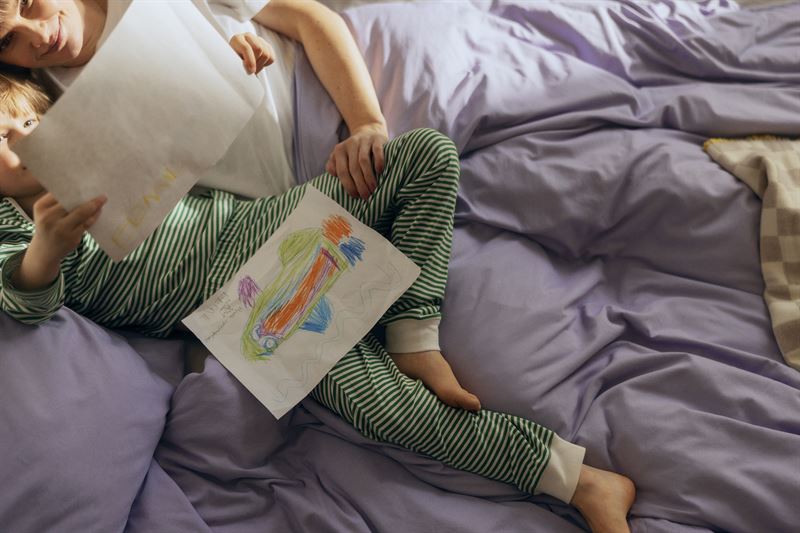Kojamo plc Press release 18 November 2025 at 8:00 a.m.

Is it cold in your apartment? Take a look at these home heating tips!
As the evenings get colder, many people dig out their thermal base layers and woolly socks from the back of their cupboards. At home, you may feel the cold deep down in your bones even if the indoor temperature is completely in line with recommendations. According to the authorities, the ideal indoor temperature is generally between 20–22°C, and the best bedroom temperature for sleeping is about 18°C.
Ville Kilpi, Director of Property Management at Lumo homes, knows from experience what the most common causes of a cool apartment are.
"The typical causes are that the thermostats or make-up air valves are configured incorrectly, furniture has been placed in front of radiators, or the humidity is high," Kilpi says.
As winter approaches, a few minor maintenance measures can make your home warmer and more comfortable without any unnecessary energy consumption.
Below, you will find our expert's top three tips for keeping your apartment warm:
1. Check the make-up air valves after the summer
Kilpi's first tip is to check that the make-up air valves in the apartment are in the winter position.
"Make-up air valves, such as gap vents in window frames, may be left open after the summer. It is important to adjust them to the correct position to maintain a comfortable indoor temperature and reduce draught. Depending on the model, the valve may also be equipped with a filter, which should be cleaned using a mild detergent solution," Kilpi explains.
Make-up air valves are located in the upper parts of windows or, in older buildings, the upper parts of the walls. They often have three settings: winter, summer and autumn. The resident should adjust the setting according to the season. However, the valves must not be completely covered, as reduced ventilation can lead to the accumulation of moisture, which can cause problems throughout the property.
You should also check the seals on windows and the balcony door.
"Over time, the seals may become brittle, loose or detached, which means that they no longer prevent cold air from coming in. Seals that are in bad condition should be replaced before freezing temperatures, as properly sealed windows and doors help keep the heat inside and reduce heating costs," Kilpi says.
2. Check the radiators
Radiators also often have seasonal settings.
"When the thermostat is still in the summer position, the water does not circulate properly in the radiators. It is important to adjust them to the winter position as soon as the heating season starts. This is in September–October, when the temperature drops below 10–15°C for an extended period of time," Kilpi notes.
Heating-related challenges are sometimes due to a simple reason.
"If furniture or curtains are placed in front of radiators, they prevent the heat from spreading into the apartment. The radiators heat the furniture while the rest of the apartment remains cool," Kilpi explains.
You should leave at least 40 centimetres of space in front of the radiator and 15–20 centimetres above the radiator so that the air can circulate and the heat is distributed evenly throughout the apartment.
"You should also note that, in the autumn, the water in the radiators may be cooler than your hand temperature (about 37°C). Even if the radiators feel cool to touch, they still heat the air in your apartment."
3. Maintain optimal humidity in your apartment
The humidity level in your apartment affects how the indoor temperature feels. High humidity makes the air feel cooler, even if the temperature is within the recommended range.
"Humidity is particularly noticeable in the autumn when the temperature drops below 10°C and the weather is rainy and humid. If you have a humidity monitor, a reading of 30–45% in the winter indicates that the level of humidity in your apartment is ideal," Kilpi says.
There are a few practical ways to manage the humidity in your apartment.
"The shower room should be kept closed after use so that the ventilation in the bathroom removes moisture effectively. Drying wet laundry in your apartment also causes moisture to accumulate in the indoor air, so it is better to dry your laundry in the drying room of your building, if one is available. Especially in a small apartment, even a single rack of wet laundry can increase the humidity and make the apartment feel cooler," Kilpi concludes.
For more information: Ville Kilpi, Director of Property Management, Lumo homes, tel. +358 508 3407, ville.kilpi@lumo.fi
Kojamo is Finland’s largest private residential real estate company and one of the biggest investors in Finland. Our mission is to create better urban living. Lumo offers environmentally friendly housing and services for the city dweller who appreciates quality and effortlessness. We actively develop the value of our investment properties by developing new properties and our existing property portfolio. We want to be the property market frontrunner and the number one choice for our customers. Kojamo’s shares are listed on the official list of Nasdaq Helsinki. For more information, please visit: https://kojamo.fi/en